Note: Yale School of the Environment (YSE) was formerly known as the Yale School of Forestry & Environmental Studies (F&ES). News articles and events posted prior to July 1, 2020 refer to the School's name at that time.
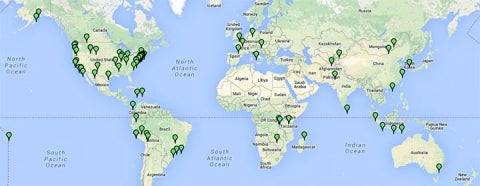 This Google Map illustrates the location of all F&ES student internships and research projects this summer. It was created by the F&ES Career Development Office.
This Google Map illustrates the location of all F&ES student internships and research projects this summer. It was created by the F&ES Career Development Office.
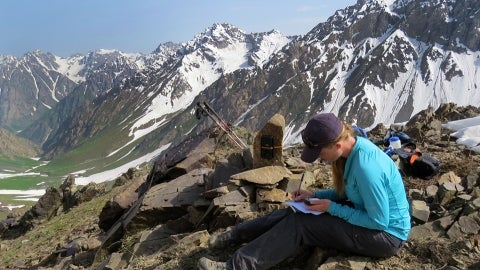
Tara Meyer M.E.Sc. ’15 worked as the Principal Investigator of a snow leopard study in Tajikistan. Her work was conducted in collaboration with Panthera, a U.S.-based NGO, and the Republic of Tajikistan’s Academy of Sciences’ Department of Zoology.
“For my research I led a camera-based study of snow leopards in the Hissar Mountain Range in western Tajikistan. My team and I placed 40 motion-censored camera traps in areas we hypothesized to be good snow leopard habitat — areas above 3,000 meters where we found signs (tracks, scat, scrapes, etc.) of either snow leopard or their main prey in the area: ibex. We also collected snow leopard scat samples which will be used to conduct a DNA analysis of the current population, and conducted key informant interviews with local hunters and other experts, and administered a community survey about human-wildlife conflicts. Together we hiked nearly 4,000 kilometers in two months (that’s roughly the distance from Los Angeles to New York City).
“One day, my Research Assistant Khalil and I were hiking up towards a mountain pass to place one of my cameras and we came to a small river. I took off my boots and waded across, but got totally soaked. Right then two men with old Soviet rifles rode up on horseback and offered to carry me across the remaining river tributaries. Khalil spoke with them and we agreed to accept their help. They ended up giving us a ride for several kilometers up into a remote valley where their yaks had been grazing unattended for weeks. When they dropped us off, they told us they were hunting ibex. Now I can tell people that I rode a horse in Tajikistan with a very friendly yak herder-slash-poacher. [
Read more]
“I had a lot of help from Yale and my partners at Panthera. The bulk of my funding came from The Schiff Fund for Wildlife, Habitat and Environment and Panthera. I also had support from Carpenter Sperry, the F&ES Summer Fund [administered by the Office of Career and Professional Development], and the Tropical Resources Institute (TRI).”
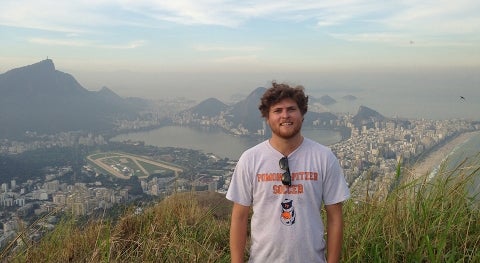
Gator Halpern M.E.M. ’15 was in Brazil, where he examined how this summer’s World Cup and the planning for an upcoming Olympics are altering the urban development of Rio de Janeiro. He worked with two local NGOs — Catalytic Communities and TEGO — and with Professor Christopher Gaffney of the Universidade Federal de Fluminense.
“My research led me to many interesting and often unseen corners of Rio de Janeiro. I’ve been able to work in a number of different favelas, interviewing residents and community leaders about the changes occurring in their communities. I’ve also been able to intermingle with some high-society figures who have been pulling the strings to make these mega-events happen.
“The summer has been full of unforgettable experiences, but one particular highlight was finagling my way into a conversation with the Vice President of FIFA. Long story short, I had to run a mile through pouring rain, sneak into the heavily-guarded Copacabana Palace Hotel, and convince the reporters from BBC to put me on a live World Report radio broadcast. I was able to make the VP a little uncomfortable on the air with a few questions about the negative impacts of hosting a World Cup, and he was nice enough to continue our conversation once the show was over.
“The experience would not have been possible without the generous support of the Tropical Resources Institute, the F&ES Summer Fund, the Carpenter-Sperry Fund, and the Center for Latin American and Iberian Studies.”
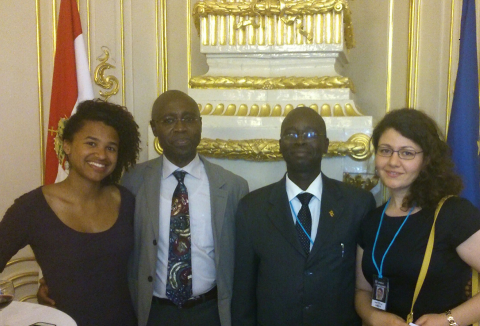 Zoraya Hightower, left, at the “Instruments for Inclusive and Sustainable Industrial Development” forum in Vienna.
Zoraya Hightower, left, at the “Instruments for Inclusive and Sustainable Industrial Development” forum in Vienna.
Zoraya Hightower M.E.M. ’15 worked as an intern with the Arab Bureau at the United Nations Industrial Development Organization in Vienna.
“As a MEM candidate specializing in Policy Analysis, most of my work involves writing reports and policy recommendations for government officials within the Arab region. The most notable of these was a justification for clean-coal technology and policy recommendations for sustainable use of coal. I was asked to write this report after UNIDO had promised Egypt funding for clean-coal technology development to solve their current energy crisis.
“Other responsibilities have included helping in the execution of the UNIDO Forum on Strategies and Instruments for Inclusive and Sustainable Industrial Development (ISID) held in Vienna in June, and the organization of an Expert Forum on Green Growth and Job Creation in the MENA Region to be held in Cairo in November.
“At the conclusion of the ISID forum, participants and organizers were invited to the Hungarian embassy for a dinner. Over drinks, I spoke to the staff council president, originally from Ghana, and the minister of trade from Uganda. They, of course, encouraged me to go to Africa, and work there. However, I told them that as a half-German/half-American — and therefore the epitome of middle-class developed world — I would feel uncomfortable going into a developing country and handing out orders. So they half-seriously told me I should marry an African man, suggesting my love for my husband would instill in me a love for Africa, and ultimately an understanding of its needs. Which sounded ridiculous to me when they said it, but the more I think about it, the more I understand where they are coming from.
“I was able to get funding from the the F&ES Summer Fund as well as the Carpenter-Sperry Fund.”
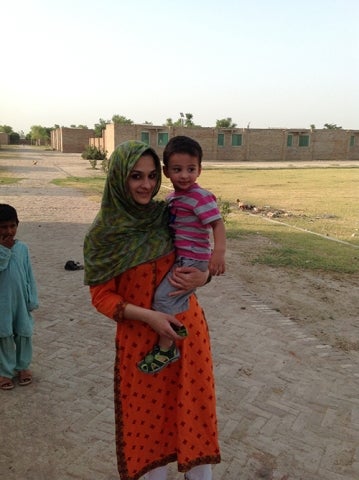
Maha Qasim M.E.M. ’15 studied the effects of post-disaster intervention in Southern Punjab, Pakistan.
“In 2010, massive floods triggered by heavy monsoon rains wiped out several-hundred-thousand homes in Pakistan. Southern Punjab was one of the worst affected areas. I worked for an organization called Engro Corporation, which had built a Model Village to rehabilitate some of the people who had been made homeless by the floods in collaboration with the Punjab Disaster Management Authority. The village was provided with off-grid solar electricity as well as other facilities including a wastewater recycling system and a school.
“During the summer, I conducted a follow-up household energy survey in collaboration with an organization called the Pakistan Poverty Alleviation Fund, which monitors the progress of these model villages. I coordinated my research with Engro and with a local NGO called the Farmers Development Organization. I also hired three local students to translate the surveys into Seraiki (the regional language) and traveled to Muzaffargarh, in Southern Punjab, to interview people in two neighboring model villages. I was interested in the different patterns of energy usage and I was surprised to see how innovative the local communities are despite their primitive living conditions.
“I was touched by the generosity of the people I interviewed. Although they barely had enough to eat, they insisted on sharing meals with us and bought ice (a luxury for an area without access to refrigerators), just so they could offer their guests cold water.
“I was funded by the Tropical Resources Institute (the TRI fellowship for summer research) and by the F&ES Summer Fund.”
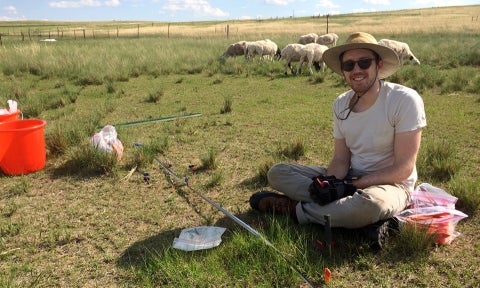
Colin Brown M.E.M. ’15 spent the summer in the Inner Mongolia grassland as a visiting scholar with the Chinese Academy of Sciences, working on an independent research project. His work arose from a collaboration with a larger research group — the National Science Foundation-funded “Living with Locusts” — and with the help of F&ES Professor Eli Fenichel and Professor Arianne Cease at Arizona State University.
“My field work took place in the Xilin River catchment basin, located in the Inner Mongolia grassland about 100 kilometers south of the nearest city of Xilinhot. The Chinese Academy of Sciences has a research station there that provided room and board, and was located only a short drive from my field site. My research project involved seeing how simulated rain events would affect short-term nitrogen availability in soil and grasses. It was about a 50/50 split between field and lab work. The field work might be best described as ‘toil’ — carrying jugs of water, taking soil cores, collecting grasshoppers, and cutting grass. Indoor work focused on processing samples and data analysis.
“The summer culminated in a final report and research presentation delivered in Beijing, at the 6th annual U.S.-China Young Scientist Forum. This was a great opportunity for all of the EAPSI fellows to share their summer experiences, and provided a venue to openly discuss the unique experience of conducting research in China.
“It was my first time in Asia, and my first time living in a foreign country for more than a handful of weeks. Much of the first week was spent in orientation, during which time our cohort was treated to touring several of the famous areas around Beijing — the Great Wall, Forbidden City, Tiananmen Square — places I previously doubted I would ever see. The biggest surprise was how similar so many aspects of life in China are to life in the United States. The cities are very modern. I found that much of what I had heard about China tended to highlight the differences between the two countries, rather than the similarities. I was warmly received most anywhere I went, in both the city and country.
“The National Science Foundation provided all funding related to travel, housing, and other living expenses abroad. Generous support was made available for project equipment costs through the Carpenter-Sperry Research Fund, and the F&ES Summer Internship and Research Fund. I also managed to secure a small research grant from the Soil Water and Conservation Society to cover additional equipment costs.”
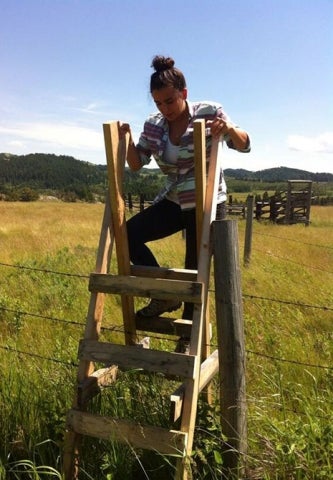
Emily Zink M.E.Sc. ’15 conducted independent research on urban planning and wildlife management in Calgary, Alberta, in collaboration with the City of Calgary Parks Department and the Miistakis Institute of the Rockies, a nonprofit environmental research organization.
“My research aims to identify urban planning, transportation, and wildlife management strategies to decrease wildlife-vehicle collisions on roadways, increase urban habitat connectivity to protect biodiversity, and facilitate human-wildlife cohabitation within the City of Calgary.
“Calgary has an area comparable to New York City but a population one-tenth the size. Urban sprawl is increasing rapidly as Alberta’s energy sector — which makes its headquarters in Calgary — grows at an astounding pace. Characterized by one major, densely developed city center and surrounding low-density suburbs, Calgary depends on a large transportation network and a car/driving "culture." In fact, the province is in the last stages of building a Ring Road around the city, estimated to cost $5 billion. The city is uniquely situated; it sits at the nexus of three major ecosystems (aspen parkland, native prairies, and the foothills of the Rocky Mountains), at the confluence of two major rivers, and is 45 minutes east of the famous Banff National Park. Expansion risks fragmenting these natural landscape, displacing animal species, and — of most concern — bringing humans and wildlife into greater contact and potential conflict. The road is where much of this conflict is already coming to pass, in the form of wildlife-vehicle collisions — mostly along the city’s perimeter. The intention of my research is to see how development can proceed while taking into account the safety of humans, ecosystems, and wildlife populations.
“One experience from the summer that can’t go unmentioned is the fact that I have had a deer cross directly in front of my car on the highway THREE times in the past three months! As someone studying wildlife-vehicle collisions, it really put in perspective how easily they can occur. And in an urban area, no less!
“I also have to say that the cliche of Canadians as extremely friendly and polite folks has held up to my experience. I have reached out to a lot of institutions asking for data/information/interviews, and never once have I heard ‘I am sorry, we can’t help you.’ Even when it went beyond their purview, people — from the police to private insurance agencies — asked insightful questions, suggested and sent resources, followed up with me unprompted to ask about my progress, and wished me well. It has been quite heartwarming!
“I am the recipient of the Hixon Center for Urban Ecology’s Research Fellowship, and the accompanying grant has funded my research, travel, and living costs.”
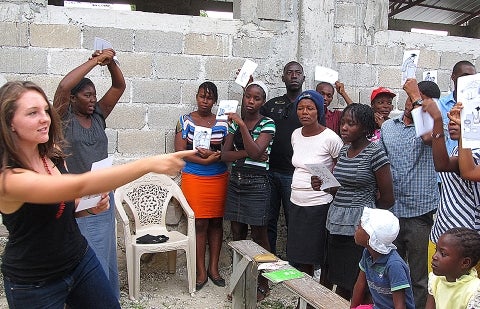
Jessica Brooks M.E.Sc. ’15 spent the summer in Port-au-Prince, Haiti, where she helped coordinate an evaluation of Community Health Clubs, a voluntary program created to improve public health through behavioral changes focused on water access, sanitation, hygiene, and environmental management. Her project was a collaboration with Lexy Adams, '13 Yale, '14 MPH, Nora Moraga-Lewy '16 Yale, and Sam Bendjemil, a fourth-year medical student at the University of Texas Health Science Center.
“We interviewed all of the health club facilitators and conducted household surveys at both member and non-member households in three case communities. We are analyzing our results now and have helped develop a shorter survey tool to be implemented by health club facilitators of over 20 clubs that will be started in the next few months.
“I think I can speak for us all when I say we were very grateful to witness the passion, enthusiasm, and dedication of the health club facilitators and members — all volunteers — as they push for better health and safer living conditions in their communities. In the words of newly trained facilitators, ‘Si nou vle, nou kapab!’ — If we want to, we can!”
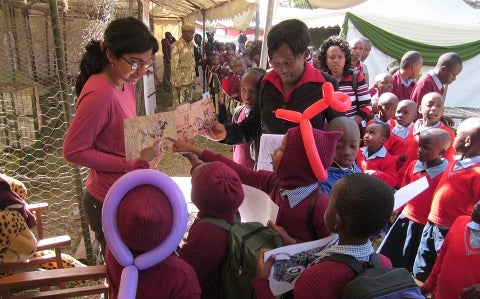
Hasita Bhammar M.E.M. ’15 spent the summer working with Action for Cheetahs in Kenya (ACK), a conservation group founded by F&ES alum Mary Wykstra. She was based in Salama.
“My main objective was to improve community perceptions of wildlife by reducing human-wildlife conflict. The biggest threat to cheetahs in Salama is land subdivision and habitat fragmentation due to settlements and farming. Additionally, the primary source of income of the community in this region is livestock and cattle breeding. When community members lose their source of income — i.e. livestock and cattle — they get frustrated and take matters into their own hands by killing cheetahs and leopards with bows and arrows. My role was to set camera traps around different bomas [enclosures for livestock and cattle] to demonstrate to the community that most of the predation in this area is in fact caused by hyenas and jackals. The poor maintenance of the fence around these bomas makes it easy for these small carnivores to dig through the ground and attack the helpless goats and cows.
“In my two months here, I have been helping ACK by introducing predator-deterrent systems known as Nite Guard Lights to stop predators from entering the boma. I also helped ACK raise awareness on strengthening fences by setting up an information booth at one of the largest agricultural shows in Kenya. More than 1,000 children and adults visited this show and we taught them how to distinguish between predators and provided information that will help cheetah conservation.
“One of the landowners that ACK has been working with has a farm in an area that is abundant in zebras, wildebeests, and elands. For him, protecting the farm is of primary concern and when I interviewed him before the predator deterrent system was set up and then again after the system was removed, the joy on his face and the fact that he had harvested his entire maize crop without any loss was truly unbelievable. When asked what he thought about the support from the ACK team, his reply was, ‘I do not have to make bows for my arrow anymore.’
“The majority of my funding was through the Rosemary Ripley Award for Business and Conservation (Yale SOM). I was also granted the Carpenter Sperry Summer Internship Funding and funding through the F&ES Summer Fund.”
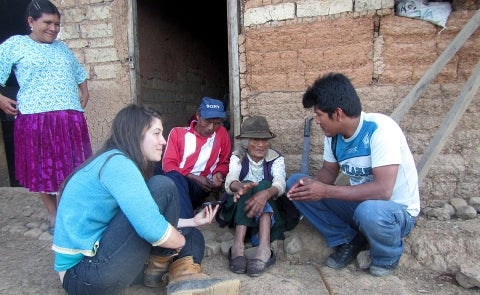
Kate Heller M.E.M. ’15 worked as a field research associate for the Wildlife Conservation Society, Bolivia, conducting Basic Necessities Surveys with the indigenous communities of the Marka Antaquilla in Apolobamba, and CIPLA-affiliated Lecos in Apolo.
“The WCS office is based in la Zona Sur of La Paz, and I spent part of my summer there. But the majority of my work was in the field, and consisted of two components. With the help of a coworker and/or community liaison who spoke either Ayamara or Quechua, I would first run a short meeting in which community members were asked to write a list of the goods and services they considered basic necessities at the family and community levels. I then took that list and interviewed a sample of individuals in each community, asking their personal opinions on each item and whether or not their family had each good or service.
“Other things I have done include peeling yucca while the woman making us dinner strangled a rooster; trying to rebuild a hole in a wooden bridge with rocks and logs so that we could pull our jeep out of it; and waking up at 5:30 a.m. to chase down folks before they left with their alpaca or to their fields.
“One memorable experience was getting — or, more accurately, seizing — the opportunity to interview a 92-year-old woman in one of the villages, who remembered when the village was a colonial hacienda with around 100 families affiliated. There are always unexpected surprises in fieldwork, whether it was a community that hadn’t been told that we were coming to work with them, or encountering a bus stuck in the mud in the road and having to spend the night in the jeep.
“I was funded by the the F&ES Summer Fund and received matching funding from Carpenter Sperry.”
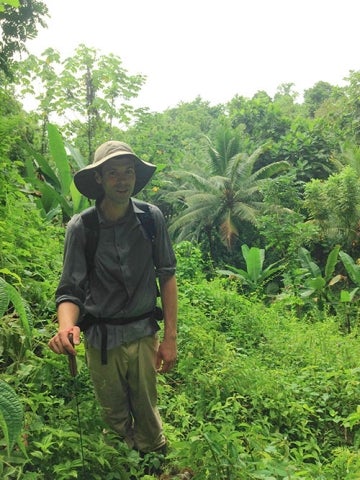
Logan Sander M.E.M. ’15 conducted research on how rural farmers promote agro-biodiversity in rural Jamaica.
“I worked in the field alongside an ethnomedical researcher from the New York Botanical Gardens, though our research projects were conducted independently. Essentially, I recorded useful plant species richness (all the plants that farmers manage or promote) on about 60 rural farms in Portland, Jamaica, and interviewed each farmer about various psychosocial, socioeconomic and agricultural attributes (use of chemicals, perceptions of environmental problems, land tenure, etc.). Most days this included some degree of tromping around the bush with a machete, helping farmers haul loads of produce back to town, and assisting with farm work. Now, back in New Haven, I will statistically relate the data from the interviews with the plant data to elucidate any relationships. The goal is to identify the farmer attributes that promote local agro-biodiversity.
“One thing that was very surprising to me was how the farmers determined what and when to plant. I came to understand that they were using the moon to time their plantings, something I was familiar with from other places I've worked. The surprising thing was that many of the farmers I worked with used a Farmer’s Almanac published in Binghamtom, New York to determine when to plant their crops. I don’t know how they came to use it, but I was expecting that they'd have a system that was a little more homegrown. In any case, it seems to be working for them, so maybe the most important thing is just to have an explanatory model that you can follow.
“I am grateful to have received funding from the Tropical Resources Institute and a Council on Latin American and Iberian Studies Travel Grant.”
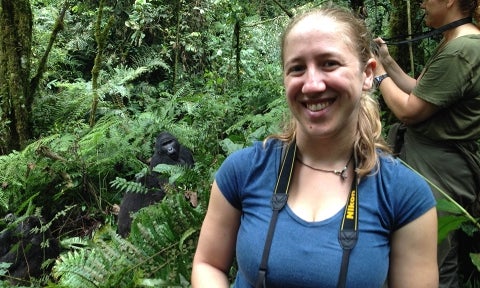
Linda Holcombe M.E.Sc. ’15 split her summer between two Africa-based projects: exploring public perspectives about penguins in South Africa (particularly within the conservation and fishing communities), and a one-month internship with the International Gorilla Conservation Programme (IGCP) in Rwanda.
“After finally connecting with an organization [in South Africa], they invited me out to see their facility and even onto their whale/seal/penguin/shark watch cruise. What was also very interesting was learning how complex the social framework surrounding wild African penguins is, far more than I had imagined even after working with them in aquariums both in South Africa and the U.S.
“On one of my first days as an IGCP intern I conducted a ‘nature walk’ to see the community programs at work. The experience was unforgettable, both in the intense hiking through the steep farmland to access the forest and in the people I met, from incredibly friendly rangers to a local community member who took a liking to me after I showed her a portrait I had done of her with my camera. I could not say more than ‘good morning’ and ‘thank you’ in Kinyarwanda, but without speaking she planted herself in front of me on the walk down and took charge of my ‘safety,’ pointing out every bush with thorns and insisting on holding my hand as I eased down slippery spots. I was really touched having only been in the country four days. I also have had the opportunity (through my own resources) to go on a gorilla tracking experience this week with a fellow F&ES student, Sarah Tolbert, who is also interning with the IGCP. We had a very reasonable hike and were able to see a silverback with three females and even a 4-month-old baby. It was great to be helping this program and getting to see why it all exists, why we and they do what we do.
“I was fully funded through the Lindsay Fellowship for Research in Africa and the Tropical Resources Institute. Because my confirmation for the additional experience [in Rwanda] came quite late, I only had partial funding generously provided through the the F&ES Summer Fund.”
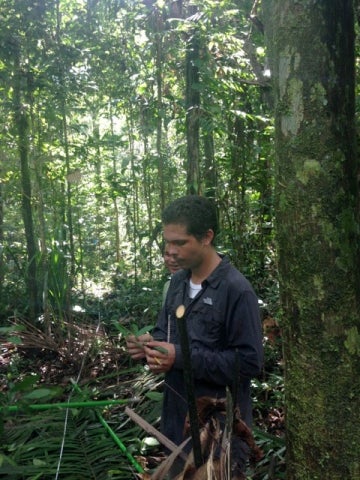
Matheus Couto M.F. ’15 spent the summer in Acre, Brazil, working with the indigenous Ashaninka community, in the reservation called Kampa of Amonea River (village Apiwtxa).
“The Ashaninka people are one of the largest indigenous groups in South America, with territories in Peru and Brazil. In the past they use to trade with the Inca empire in Peru, but they started to move east, towards Brazil. This territory was recognized by the Brazilian government in 1992; Previously they were semi-nomadic, but became fixed at the entrance of the territory to better protect the land. They have been working within and without their territory to reduce pressure from illegal loggers, fishers and hunters.
“I am studying the forest regeneration on the shifting-agriculture sites. Usually after three years of cultivation of banana, cassava, cotton and fruit-trees, the area is abandoned and the Amazon forest strongly recover. I am trying to understand how their agro-forestry management affects forest regeneration, and I am studying carbon stocks and tree diversity in the abandoned agriculture sites and comparing to the old growth forest. The state of Acre recently recognized that indigenous lands provide several ecosystem services and are effective in combating deforestation. Therefore in the recently developed ecosystem services legislation, the indigenous groups are listed as one of the beneficiary groups. The research will provide information for the Ashaninka and partners develop a mechanism of payments for ecosystem initiative, which the NGO Forest Trends (from the U.S.) is one of the partners.
“I am impressed by the way the Ashaninka maintain their culture. They have adapted their education system, and preserved Asheninka as their primary language. The cultural happenings are part of the school calendar, like the season when they prepare the land for planting, or learning how to make their clothes. This was impacting for me.
“This research became possible with support form the Tropical Resources Institute, the Yale F&ES Summer Internship & Research Project Fund, Forest Trends, F&ES Silviculture Lab and MacMillan Center/LAIS Summer Travel Grant.”
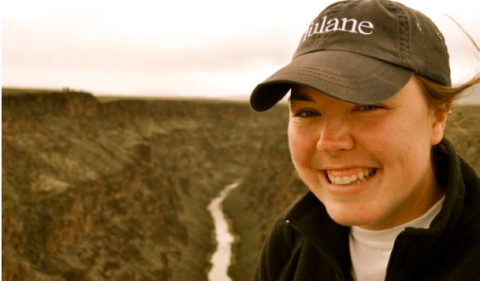
Michelle Camp M.E.M. ’15 interned at the Murray-Darling Basin Authority, an independent statutory authority created by the Australian government to manage water resources in the Murray-Darling Basin, located in southeastern Australia. Despite its dry and variable climate, and frequent droughts, the MDB is an agricultural center for the country.
“At the MDBA, I assisted the Stakeholder Engagement and Water Resource Plan Implementation teams. Both teams are working to implement the ‘Basin Plan,’ which aims to sustainably manage water resources at the basin-wide scale.
“The internship exposed me to the inner workings of management, specifically environmental/water management. Throughout my time in the office, I came to understand the dynamic of the organization and the coordination among the many teams within it. Such coordination is crucial, especially in terms of effectively implementing the Basin Plan, because multiple teams with expertise in various areas have to work together to manage basin-wide water resources.
“Also I was exposed to another critical component of implementation: river operations for environmental water delivery. After studying and working in policy, it’s incredibly useful to understand how river managers and engineers apply water policies on the ground. For instance, I visited several structures that are designed to deliver water to environmental assets throughout the Basin. This tour complemented my experience in environmental flows policy.
“I procured funding from the Yale F&ES Summer Internship & Research funds to help finance my internship in Australia.”
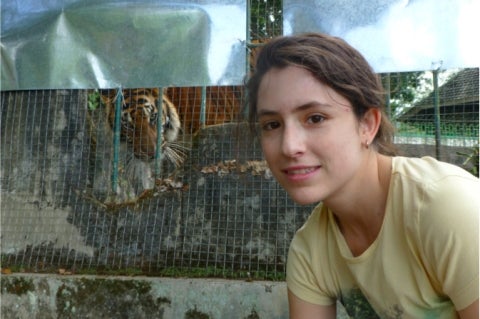
Melissa Arias M.E.M. ’15 spent the summer in Central Sumatra, Indonesia, where she completed an internship and conducted research for the World Wildlife Fund’s Tiger Conservation Program.
“My research focused on the RIMBA wildlife corridor, which stretches across Riau, Jambi and West Sumatra provinces. The goal of this corridor is to enhance connectivity of wildlife species across designated protected areas and multiple-use human dominated lands.
“The internship involved monitoring tiger populations across the landscape through the use of camera traps and assessing threats from forest conversion, poaching, and increased human-wildlife conflict. The research part of my summer experience included an analysis of the information collected from the camera traps. I am trying to understand how tigers and other smaller felids (including clouded leopards, leopard cat, marbled cat, and golden cat) use the landscape in Central Sumatra, including areas that are currently palm oil or logging concessions. By using several species distribution models, I am hoping to help inform decision-making about which areas to prioritize for wildlife conservation. I am also interested in comparing the results with information about ecosystem services in the area, which will be used to develop management plans for the landscape.
“I received funding support from two main sources: the Tropical Resources Institute and the Council for South East Asian Studies.”
 This Google Map illustrates the location of all F&ES student internships and research projects this summer. It was created by the F&ES Career Development Office.
This Google Map illustrates the location of all F&ES student internships and research projects this summer. It was created by the F&ES Career Development Office.


 Zoraya Hightower, left, at the “Instruments for Inclusive and Sustainable Industrial Development” forum in Vienna.
Zoraya Hightower, left, at the “Instruments for Inclusive and Sustainable Industrial Development” forum in Vienna.










